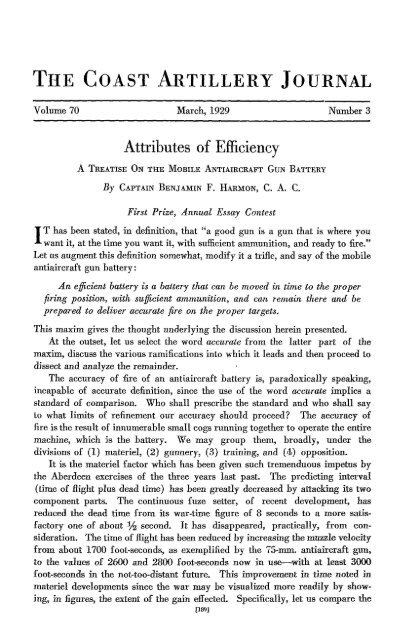THE COAST ARTILLERY JOURNAL - Air Defense Artillery
THE COAST ARTILLERY JOURNAL - Air Defense Artillery
THE COAST ARTILLERY JOURNAL - Air Defense Artillery
Create successful ePaper yourself
Turn your PDF publications into a flip-book with our unique Google optimized e-Paper software.
<strong>THE</strong> <strong>COAST</strong> <strong>ARTILLERY</strong> <strong>JOURNAL</strong><br />
Volume 70 March, 1929<br />
Attributes of Efficiency<br />
A TREATISE ON <strong>THE</strong> MOBILE ANTIAIRCRAFT GUN BATTERY<br />
By CAPTAIN BENJAMIN F. HARMON, C. A. C.<br />
First Prize, Annual Essay Contest<br />
Number 3<br />
IT has been stated, in definition, that "a good gun is a gun that is where you<br />
want it, at the time you want it, with sufficient ammunition, and ready to fire."<br />
Let us augment this definition somewhat, modify it a trifle, and say of the mobile<br />
antiaircraft gun battery:<br />
An efficient battery is a battery that can be moved in time to the proper<br />
firing position, with sufficient ammunition, and can remain there and be<br />
prepared to deliver accurate fire on the proper targets.<br />
This maxim gives the thought underlying the discussion herein presented.<br />
At the outset, let us select the word accurate from the latter part of the<br />
maxim, discuss the various ramifications into "\\Chichit leads and then proceed to<br />
dissect and analyze the remainder.<br />
The accuracy of fire of an antiaircraft battery is, paradoxically speaking,<br />
incapable of accurate definition, since the use of the word accurate implies a<br />
standard of comparison. Who shall prescribe the standard and who shall say<br />
to what limits of refinement our accuracy should proceed? The accuracy of<br />
fire is the result of innumerable small cogs running together to operate the entire<br />
machine, which is the battery. We may group them, broadly, under the<br />
divisions of (1) materiel, (2) gunnery, (3) training, and (4) opposition.<br />
It is the materiel factor which has been given such tremenduous impetus by<br />
the Aberdeen exercises of the three years last past. The predicting interval<br />
(time of flight plus dead time) has been greatly decreased by attacking its two<br />
component parts. The continuous fuze setter, of recent development, has<br />
reduced the dead time from its war-time figure of 8 seconds to a more satisfactory<br />
one of about ~ second. It has disappeared, practically, from consideration.<br />
The time of flight has been reduced by increasing the muzzle velocity<br />
from about 1700 foot-seconds, as exemplified by the is-rum. antiaircraft gun,<br />
to the values of 2600 and 2800 foot-seconds now in use--with at least 3000<br />
foot-seconds in the not-too-distant future. This improvement in time noted in<br />
materiel developments since the war may be visualized more readily by showing,<br />
in figures, the extent of the gain effected. Specifically, let us compare the<br />
[139]
















